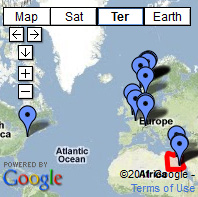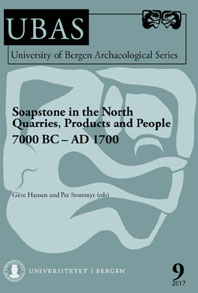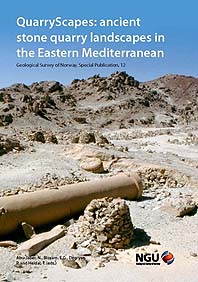Search this site
Welcome!
I work with the geoarchaeology of old stone: quarries, monuments, rock art. And I try to figure out about their weathering, and conservation using traditional crafts. I also burn lime the traditional way. My domestic services are managed through FABRICA, a registered Norwegian company established with good partners. On this website I publish articles on many aspects of cultural heritage. For the joy of old stone! Per Storemyr
Visit FABRICA’s website!

-
-
Recent posts
- Tradisjonell kalkbrenning i små, vedfyrte ovner. Erfaringer fra 6 brenninger i Tvedestrand
- Vinterbrenning av Brevikkalk. Med beskrivelse av kalkens geologi og egenskaper
- Middelalderkirker i stein: Hva mikroskopanalyse av kalkmørtler kan fortelle om historie, skader og mørtelvalg for restaurering
- Norwegian medieval lime mortars under the microscope
- Småskala kalkbrenning. Geologisk mangfold i kulturminnevernets tjeneste
Popular right now
Find posts by Google Maps

Follow on:

Follow on Facebook
SOAPSTONE! New book on its archaeology and history!

Book: The Stones of Nidaros Cathedral

Book: QuarryScapes

Get informed! State of the Art on natural stone today:

Category Archives: New projects
Partner in the Borgund Kaupang Project – on the rise and fall of a medieval town
My company is proud partner in the Borgund Kaupang Project (2019-2023), on the rise and fall of a “lost” medieval town. The project is coordinated by the University of Bergen and financed by the Norwegian Research Council. Together with Alf Tore Hommedal, my task is to source building materials such as marble, soapstone and lime for mortar and to interpret the whole building process, from quarries to churches. Thanks a lot to project manager Gitte Hansen, Therese Nesset and a great international team for a fine kick-off meeting in Ålesund last week! Continue reading
Posted in Marble, New projects, Norway, Old quarries
Tagged Borgund Kaupang, Borgundkaupangen, life in the middle ages, lime, lime mortar, marble, Middle Ages, soapstone
Leave a comment
Selja kloster: Hvor kom middelalderens kalkmørtel fra?
Det har en stund vært kjent at hvit og fin marmor ble brent for å lage kalkmørtel til byggingen av Selja kloster i middelalderen. Men hvor ble det brent? Hvor kommer marmoren fra? Her ute i havgapet, langt vest i Norge, er det ingen marmorforekomster. Man må til Sunnmøre eller Bergenstraktene for å finne marmor. Til marmor på Sunnmøre er det ikke langt, bare 20 km i luftlinje. Men i veien står Norges farligste hav, Stadhavet. I middelalderen ble bygningsmaterialer fraktet med båt! Turte man å gå 50-60 km på dette farlige havet, attpåtil med ytterst farlig brentkalk i lasten? Fraktet man heller ubrent kalk? Eller tok man heller den lange turen sørfra, mer enn 250 km? Vi har ennå ikke svaret, men med undersøkelser innen Riksantikvarens bevaringsprogram for ruiner begynner vi å nærme oss. Continue reading
Posted in Archaeology, Marble, New projects, New publications, Norway, Old quarries
Tagged georkeologi, kalkbrenning, kalkovn, lime burning, lime mortar, limekiln, marble, Middle Ages, Selja, Sunnmøre
1 Comment
Firmaet mitt er nå del av FABRICA.no / My company is now part of FABRICA.no
See English text below Enkeltpersonforetaket mitt “Archaeological & Conservation Services” er fra april 2019 del av nyskapningen FABRICA kulturminnetjenester as. Sammen med Morten Stige og Vegard Røhme håper jeg å kunne tilby enda bedre tjenester til kulturminnevernet. Ideen er enkel: … Continue reading
Posted in Monument conservation, New projects, Norway
Tagged conservation, Cultural heritage, FABRICA, kulturminnevern, stein
Leave a comment
Happy New Year to clients, partners and followers! With photos from work and excursions in 2018
I wish clients, partners and followers of my website a Happy and Prosperous New Year! I am glad for the trust you have shown my little company and me in 2018. And I look forward to aid in conservation and archaeological work at monuments, old stone quarries and rock art sites in 2019. Below is a gallery of photos from some of the sites I worked at and visited on excursions last year. Also, a list of reports, publications and web-articles finalised in 2018 is attached. They give a glimpse of activities, many of which will continue. See you in the new year! Continue reading
Posted in Monument conservation, New projects, New publications, New reports, Norway, Old quarries, Rock art
Tagged conservation, Italy, Norway, Romania
1 Comment
Burning sea shells to make quicklime
Burning sea shells to make quicklime once was a great tradition in the North-Atlantic region. In Millstone Park, Hyllestad (W-Norway), we have built two limekilns, reviving old lime burning traditions, involving craftspeople, volunteers and the public. Recently we burnt sea shells to make lime paint and mortar! Read about the experiment in a new poster and web article. Continue reading
Posted in New projects, New publications, Uncategorized
Tagged experimental archaeology, Hyllestad, lime, lime burning, limekiln, Millstone Park, scallop, sea shell
2 Comments
Novel micro-images of lime mortar destruction by frost weathering
Frost is here again and thus weak building materials are at risk, for example traditional lime mortars applied during the last summer season. Over the last few days I was able to observe frost heaving in a lime mortar that has not properly hardened/carbonised due to recent rainy and moist weather. As far as I know, no one has previously documented such ice crystal growth, on a micro-scale. The phenomenon is akin to frost heaving in a soil profile: The force of growing ice whiskers lifting the uppermost parts of the soil. Continue reading
The limekiln at Hyllestad, Western Norway: Rebuilding a new, “historic” kiln for burning lime
Last year we built a limekiln at Millstone Park in Hyllestad, Western Norway, reported on this website. The kiln was built in a traditional fashion, following Roman and Medieval principles. Experimental archaeology! After one burn, which gave excellent quicklime, the kiln was, unfortunately, badly damaged. Cracks in the masonry! So we had to rebuild the kiln to be able to produce more quicklime! Over the last few months a team of professional, Norwegian masons and local volunteers, 15 people altogether, has undertaken the task: Just a little more work to be done, and soon we’ll have two(!) limekilns, one big and one small – for producing “historic” quicklime in the years to come. For restoring old stone buildings.
Below, you will find a report of the rebuilding, written in Norwegian. Use Google Translate if you are not familiar with the language. The report is written by me and was first published on the website of Millstone Park (kvernsteinsparken.no) a couple of days ago. I work part-time as an Associate Professor for Millstone Park and I am project leader and responsible for building, rebuilding and running the limekiln. Great combination of craft and theory, experimental archaeology! But I’m also involved, privately and through my company, Archaeology & Conservation Services, as a local volunteer. Building and running a historic limekiln is a very big task, many months of work for many people! And though the Norwegian Directorate for Cultural Heritage is a generous sponsor of the project, voluntary work is indispensable. Thank you all! And here’s the report, with many videos and photos: Continue reading
Posted in Archaeology, Marble, New projects, Norway
Tagged Hyllestad, Kvernsteinsparken, limekiln, marble, Norway
3 Comments
Burning the beaches. Happy New Year from the Faroe Islands!
The Faroe Islands, in the middle of the North Atlantic Ocean. Basalt and other volcanic stone everywhere! Yet, many buildings on the islands were erected by the use of lime mortar, from the Middle Ages on. There is absolutely no limestone on the Faroes. Thus, lime mortar had to be produced by “burning the beaches” – collecting shells from beach deposits, stacking the shells above a fire in a field kiln – and let it happen: Hold the temperature at some 900 degrees centigrade for a couple of days, and out comes quicklime to be mixed with water and beach sand for the mortar. Continue reading
Posted in Archaeology, New projects, Old quarries
Tagged Faroe islands, lime burning, lime mortar, limekiln
5 Comments
HOTMIX! Nybrent Hyllestadkalk leskes og testes som restaureringsmørtel på Stavanger domkirke
Endelig i gang med hotmix! Med lesking og testing av nybrent Hyllestadkalk til bruk i mørtel for restaurering. Som mange vil huske, brant Norsk Kvernsteinsenter lokal marmor i en nybygd «middelalderovn» i Hyllestad sist juni, et prosjekt støttet av Riksantikvaren. Planen er å leske og teste brentkalken på flere restaureringsprosjekter i Norge, bl.a. på Selja klosterruiner og Stavanger domkirke. Sidene jeg regelmessig jobber sammen med kollegaer i Stavanger, har vi nå gjort flere tester på domkirken med George Murphy og Bjørn Idland, som er restaureringsmurere ved Arkeologisk Museum (UiS). Det er ikke lett å leske kalk som er brent på tradisjonell måte. For det vil alltid være halvbrente og ubrente biter i slik kalk. Akkurat som i middelalderen. Vi lesket kalken på tre ulike måter, og det var liten tvil: tradisjonell hotmix ga det foreløpig beste resultatet! Continue reading
Posted in Monument conservation, New projects, Norway
Tagged experimental archaeology, lime burning, lime mortar, limekiln, marble
1 Comment
Experimental archaeology: Building a “classic”, intermittent limekiln and burning marble at Millstone Park, Hyllestad, Western Norway
It took us about six months: Building a cylindrical limekiln of the classic Roman/Medieval type with local materials only – stone rubble and clay. In June this year, we built the firing chamber and filled the kiln with 2.5 tons of local marble, covered the kiln with clay on a layer of spruce branches and started burning. Five days and five nights with much of the local community involved! Here’s an extended photo story of the project – the first of its kind in Norway. The quicklime (burnt marble) will be tested at Selja medieval monastery and other restoration projects in Norway. Thanks to all paid and volunteers and support from The ruin restoration programme of the Norwegian Directorate for Cultural Heritage, as well as Hyllestad Municipality! The project was carried out by The Norwegian Millstone Centre/The Museums in Sogn og Fjordane County. Continue reading
Posted in Marble, Monument conservation, New projects, Norway
Tagged experimental archaeology, Hyllestad, kalkbrenning, kalkovn, lime burning, limekiln, marble
13 Comments

